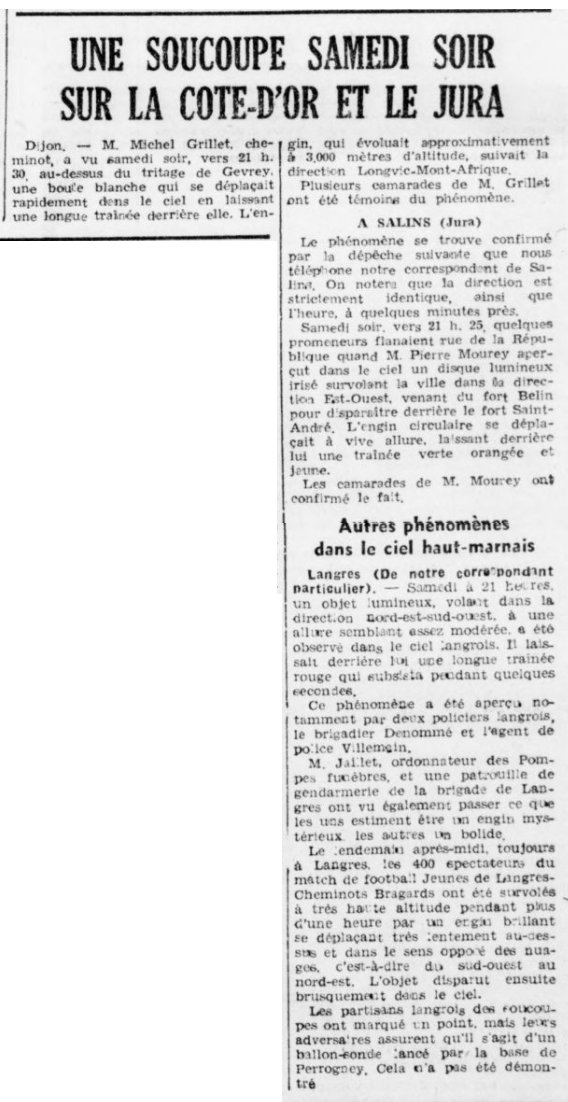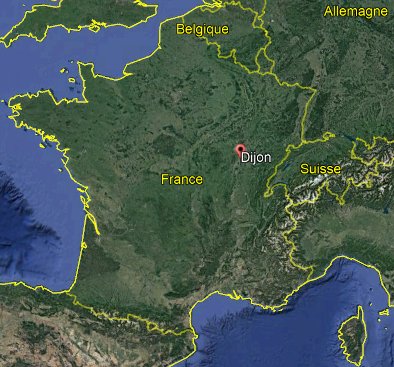
The index page for the 1954 French flap section of this website is here.
Reference for this case: 16-Oct-54-Dijon.
Please cite this reference in any correspondence with me regarding this case.
In the regional newspaper La Bourgogne Républicaine, of Dijon, one read on page 4 for October 18, 1954, among other sightings titeld "saucer":
Dijon. -- Mr. Michel Grillet, railway worker, saw Saturday evening, around 9:30 p.m. above the marshalling yard of Gevray, a white ball which moved rapidly in the sky leaving a long trail behind it. The craft, which moved approximately at 3000 meters of altitude, followed the direction Longvic-Mont-Afrique.
Several of Mr. Grillet's comrades witnessed the phenomenon.
On October 16, 1954, at approximately 09:30 p.m., a big meteor passed over France, apparently identified as such by an Air Force investigation committee, but often interpreted as a "flying saucer" or a "flying cigar" by witnesses.
In 1956, in a US saucerist magazine, pioneer ufologist Aimé Michel mentioned an observation in Dijon, giving neither source nor details, and believing he demonstrated that it was not a meteor.
Pioneering ufologist Charles Garreau, who was from this region, journalist at La Bourgogne Républicaine did the same in his 1956 book "Alerte dans le Ciel."
In 1958, in his book "Flying Saucers and the Straight Line Mystery", Aimé Michel had changed his mind, explaining these events of October 16, 1954, around 09:30 p.m., as in general explained by a meteor.
This would not prevent others thereafter from continuing to present the event as if it were sightings of an unknown flying object.
[Ref. lbr1:] NEWSPAPER "LA BOURGOGNE REPUBLICAINE":

|
Dijon. -- Mr. Michel Grillet, railway worker, saw Saturday evening, around 9:30 p.m. above the marshalling yard of Gevray, a white ball which moved rapidly in the sky leaving a long trail behind it. The craft, which moved approximately at 3000 meters of altitude, followed the direction Longvic-Mont-Afrique.
Several of Mr. Grillet's comrades witnessed the phenomenon.
The phenomenon is confirmed by the following dispatch that our correspondent in Salins telephones to us. Note that the direction is strictly identical, as well as the hour, to within a few minutes.
Saturday evening, around 9:25 p.m., a few wanderers were strolling rue de la République when Mr. Pierre Mourey saw in the sky an iridescent luminous disc flying over the city in an east-west direction, coming from Fort Belin to disappear behind Fort Saint-André. The circular craft was moving at high speed, leaving behind a green orange and yellow trail.
Mr. Mourey's comrades confirmed the fact.
Langres (From our own correspondent). -- Saturday at 9 p.m., a luminous object, flying in the north-east-south-west direction, at a seemingly fairly moderate pace, was observed in the Langres sky. It left behind a long red trail that lingered for a few seconds.
This phenomenon was observed in particular by two police officers from Langres, Brigadier Denommé and police officer Villemain.
Mr. Jaillet, the funeral director, and a gendarmerie patrol from the Langres brigade also saw what some consider to be a mysterious craft, others a meteor.
The next afternoon, still in Langres, the 400 spectators of the Langres Youth - Cheminots Bragards soccer game were overflown at very high altitude for more than an hour by a bright craft moving very slowly above and in the opposite direction of the clouds, i.e. from southwest to northeast. The object then suddenly disappeared into the sky.
The Langres saucer supporters have scored a point, but their opponents ensure that it is a weather balloon launched by the Perongney base. This has not been demonstrated.
[Ref. aml7:] AIME MICHEL:
[... other cases...]
The object [of October 16, 1954] began then to cross Cote-d'Or. It was observed at Damparis, then at Dijon.
[... other cases...]
The French Air Force Inquiry Commission, after studying the case [of the October 16, 1954 sightings in the night], concluded that the object was a "slow meteor." The Commission did not take into account the change of direction of the last Paris sighting. To the several witnesses who saw the UFO halt in the sky, the Commission answered: "Optical Illusion," and since this time differentials reported suggested a meteor traveling at an impossibly slow speed (2400 miles per hour), the Commission supposed that the witnesses' watches had broken.
[... other cases...]
[Ref. aml1:] AIME MICHEL:
Aimé Michel wrote about the October 16, 1954, 09:30 p.m. meteor:
THE TEST OF THE METEOR. October 16, as if it was purposely, a splendid meteor crossed the north of France towards 09:30 p.m.. It was observed on a score of departments by thousands of people, from the Allier to Lorraine and from the Swiss border to Paris. Naturally many witnesses believed to have seen a Flying Saucer and said so. The newspapers printed "Flying Saucer in Orly", or "in Montididier", or "in Metz." But once again the description made by all these weak brains appeared of a remarkable honesty.
[...]
The innumerable gathered testimonys show indeed that even when the witnesses called "Flying saucer" the observed object, their description is identical on 200.000 square kilometres where the visible phenomenon was visible: an "orange ball followed by a trail", a "large luminous ball with a tail", a "flying egg followed by a trail", a "bottle's bottom with a trail of thirty times its diameter", etc. The same phenomenon is uniformly described.
[...]
[Ref. via3:] UFOLOGY BULLETIN "VIMANA 21":
This magazine listed this case:
|
54 10 16 21H30 LN Perrigny |
[Ref. lgs1:] LOREN GROSS:
October 16th [1954]
[...other cases...]
More "meteor" sightings
[...other cases...]
At 9:25 p.m. residents of Salins, France, noticed something coming out of the southeast sky from the direction of northern Italy. As the thing passed overhead it appeared as a dull-glowing lenticular shape trailing a luminous stream of smoke. Moments later the lenticular body passed over the cities of Dole and Montmirey still on a northwest trajectory. The elongated form was then spotted at Damparis and Dijon. The object was at a high altitude since observers some distance to the right and left of the object's course could see the thing travel from horizon to horizon. At 9:35 p.m., continuing in a straight line, the lenticular body appeared over Paris, causing some concern at Orly airport which put all air traffic on hold while the phenomenon was in sight. Some people in the French capital claimed they saw the object come to a stop while others even asserted the object made a turn to the west.
The French Air Force Inquiry Commission looked into the case and concluded that a "slow meteor" was responsible, and that those who said they had seen a course change had merely suffered from an optical illusion. To explain the duration of the object's passage, the French Commission suggested that witnesses' timepieces were not set properly.
Aime Michel thought more of the case than the military because he had knowledge of a sighting near St. Malo, a town that lies west of Paris on the coast of Brittany. The time of this sighting was not known but there may have been a connection with the "slow meteor." What was seen at St. Malo, however, did not resemble the supposed meteor. According to the witness two objects raced across the sky and a third object was seen intercepting the first two at a right angle. This new formation of three objects sped away leaving a thin vapor trail behind them. 138.
[Ref. lcn1:] LUC CHASTAN:
The author of the database data indicates that in Dijon in Côte-d'Or, on October 16, 1954 at 09:30 p.m., several people observed from different places since an object evolve in the sky.
Railwaymen being at the Dijon-Perrigny railway sorting specified that the object was a white ball leaving a long trail behind itself. It dove towards Mount Afrique in the West of Dijon.
The source is indicated as "Alerte dans le ciel by Garreau Charles ** Alain Lefeuvre 1981".
[Note: the Charles Garreau book "Alerte dans le Ciel" of 1981 is not his book "Alerte Dans le Ciel" of 1956.]
[Ref. uda1:] "UFODNA" WEBSITE:
The website indicates that on 15 November 1954 at 08:30 in Dijon, France, "An unidentified object was sighted, but with appearance and behavior that most likely would have a conventional explanation. One object was observed by six witnesses."
The source is indicated as "Vallee, Jacques, Computerized Catalog (N = 3073)".

|
The meteor of October 16, 1954, at 09:30 p.m.
In 1956, Aimé Michel argued [aml7] against the meteor explanation of the sightings at that time, that the hours indicated by the witnesses allowed him to calculate that the "object" flew at only 3000 km/h., too slow for a mateor.
I repeatedly explained in such cases that the said hours are almost never accurate to the minute. We have a nice example here, as the witness, or the Press, said: "around 9:30 p.m.", not "at exactly 09:30 p.m."
(These keywords are only to help queries and are not implying anything.)
Dijon, Côte-d'Or, night, multiple, railwaymen, Dijon-Perrigny, ball, white, trail, fast, Michel Grillet, station, Gevray, direction
[----] indicates sources that are not yet available to me.
| Version: | Created/Changed by: | Date: | Change Description: |
|---|---|---|---|
| 0.1 | Patrick Gross | September 14, 2005 | First published. |
| 1.0 | Patrick Gross | December 27, 2009 | Conversion from HTML to XHTML Strict. First formal version. Addition [uda1]. |
| 1.1 | Patrick Gross | February 26, 2021 | Additions [lbr1], [aml7], [lgs1], Summary. Explanations changed, were "The meteor of October 16, 1954, at 09:30 p.m." |